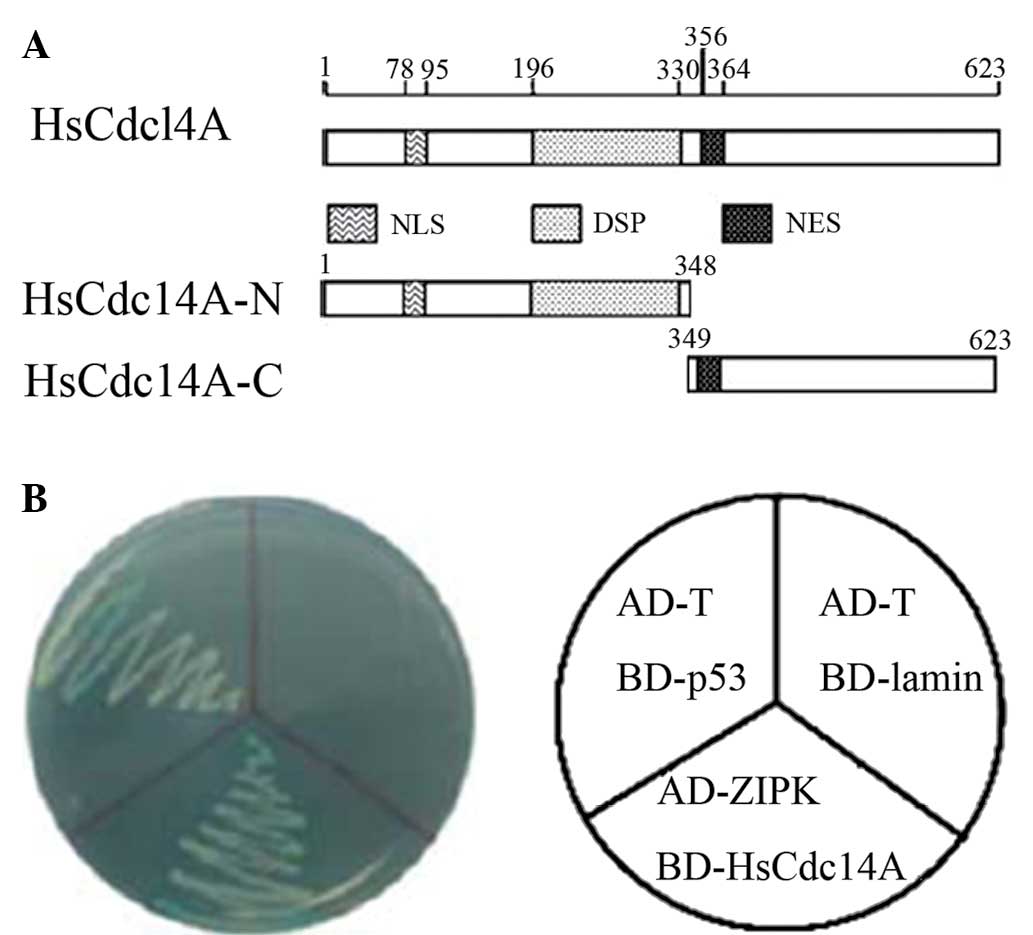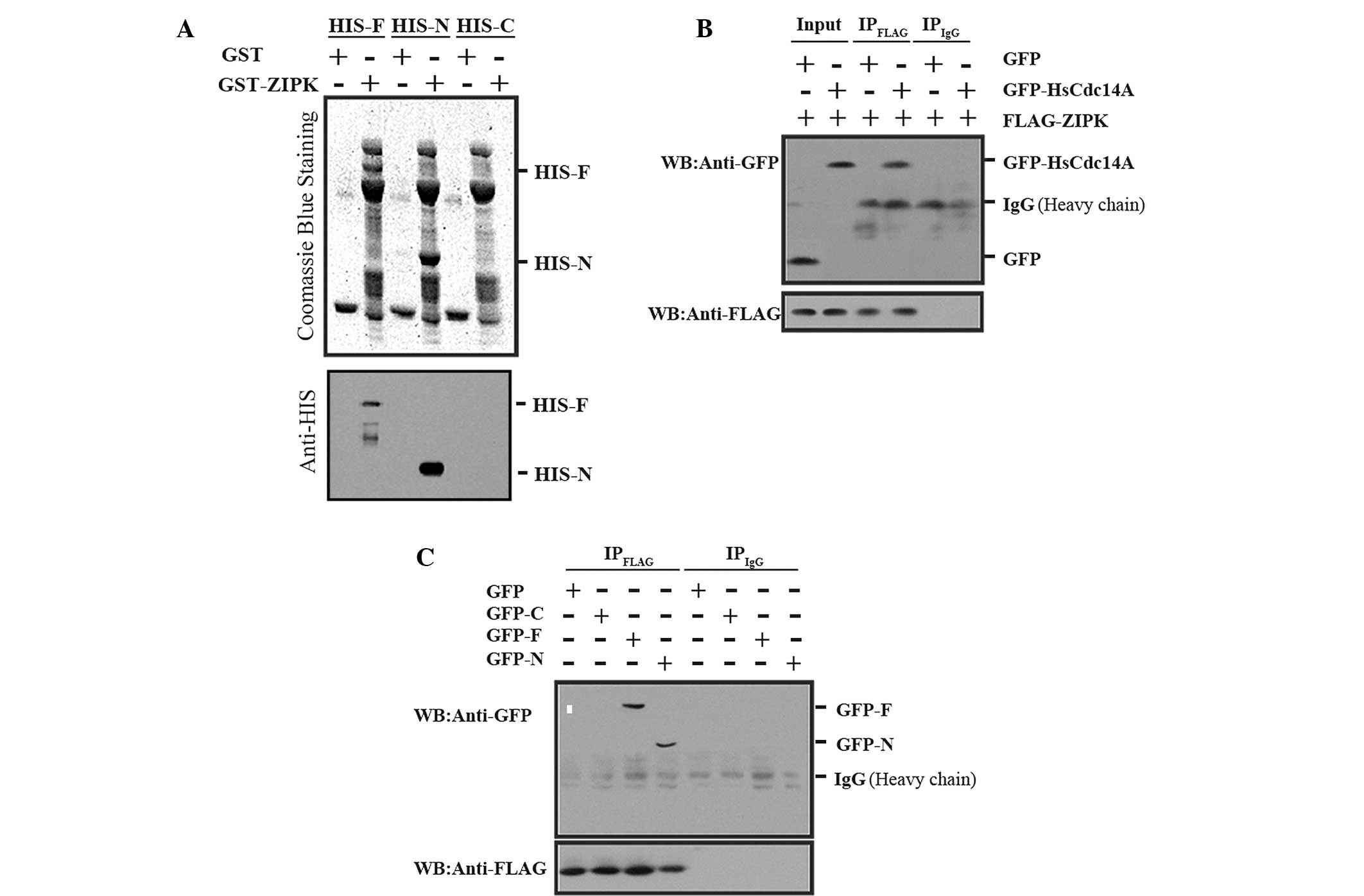|
1
|
Kawai T, Matsumoto M, Takeda K, Sanjo H
and Akira S: Zip kinase, a novel serine/threonine kinase which
mediates apoptosis. Mol Cell Biol. 18:1642–1651. 1998.PubMed/NCBI
|
|
2
|
Kogel D, Plottner O, Landsberg G,
Christian S and Scheidtmann KH: Cloning and characterization of
DLK, a novel serine/threonine kinase that is tightly associated
with chromatin and phosphorylates core histones. Oncogene.
17:2645–2654. 1998. View Article : Google Scholar : PubMed/NCBI
|
|
3
|
Komatsu S and Ikebe M: ZIP kinase is
responsible for the phosphorylation of myosin II and necessary for
cell motility in mammalian fibroblasts. J Cell Biol. 165:243–254.
2004. View Article : Google Scholar : PubMed/NCBI
|
|
4
|
Engemann H, Heinzel V, Page G, Preuss U
and Scheidtmann KH: DAP-like kinase interacts with the rat homolog
of schizosaccharomyces pombe CDC5 protein, a factor involved in
pre-mRNA splicing and required for G2/M phase transition. Nucleic
Acids Res. 30:1408–1417. 2002. View Article : Google Scholar : PubMed/NCBI
|
|
5
|
MacDonald JA, Borman MA, Muranyi A, Somlyo
AV, Hartshorne DJ and Haystead TA: Identification of the endogenous
smooth muscle myosin phosphatase-associated kinase. Proc Natl Acad
Sci USA. 98:2419–2424. 2001. View Article : Google Scholar : PubMed/NCBI
|
|
6
|
Niiro N and Ikebe M: Zipper-interacting
protein kinase induces Ca(2+)-free smooth muscle contraction via
myosin light chain phosphorylation. J Biol Chem. 276:29567–29574.
2001. View Article : Google Scholar : PubMed/NCBI
|
|
7
|
Sato N, Kawai T, Sugiyama K, et al:
Physical and functional interactions between STAT3 and ZIP kinase.
Int Immunol. 17:1543–1552. 2005. View Article : Google Scholar : PubMed/NCBI
|
|
8
|
Vetterkind S, Illenberger S, Kubicek J, et
al: Binding of par-4 to the actin cytoskeleton is essential for
Par-4/Dlk-mediated apoptosis. Exp Cell Res. 305:392–408. 2005.
View Article : Google Scholar : PubMed/NCBI
|
|
9
|
Vetterkind S and Morgan KG: The
pro-apoptotic protein Par-4 facilitates vascular contractility by
cytoskeletal targeting of ZIPK. J Cell Mol Med. 13:887–895. 2009.
View Article : Google Scholar :
|
|
10
|
Li L, Ernsting BR, Wishart MJ, Lohse DL
and Dixon JE: A family of putative tumor suppressors is
structurally and functionally conserved in humans and yeast. J Biol
Chem. 272:29403–29406. 1997. View Article : Google Scholar : PubMed/NCBI
|
|
11
|
Lou Y, Yao J, Zereshki A, et al: NEK2A
interacts with MAD1 and possibly functions as a novel integrator of
the spindle checkpoint signaling. J Biol Chem. 279:20049–20057.
2004. View Article : Google Scholar : PubMed/NCBI
|
|
12
|
Chen JS, Hu HY, Zhang S, et al: Brap2
facilitates HsCdc14A Lys-63 linked ubiquitin modification.
Biotechnol Lett. 31:615–621. 2009. View Article : Google Scholar : PubMed/NCBI
|
|
13
|
Gietz RD and Schiestl RH: Applications of
high efficiency lithium acetate transformation of intact yeast
cells using single-stranded nucleic acids as carrier. Yeast.
7:253–63. 1991. View Article : Google Scholar : PubMed/NCBI
|
|
14
|
Zheng Q, Huang ZH, Tang FX, Huang ZZ and
Che XY: Highly efficient construction of recombinant adenovirus
containing double suicide gene driven by cytomegalovirus promoter
using two-step CaCl2 transformation method. Di Yi Jun Yi Da Xue Xue
Bao. 6:575–577. 2003.(In Chinese).
|
|
15
|
Zhou W, Wang X, Li L, et al: Depletion of
tubulin polymerization promoting protein family member 3 suppresses
HeLa cell proliferation. Mol Cell Biochem. 333:91–98. 2010.
View Article : Google Scholar
|
|
16
|
Preuss U, Bierbaum H, Buchenau P and
Scheidtmann KH: DAP-like kinase, a member of the death-associated
protein kinase family, associates with centrosomes, centromers, and
the contractile ring during mitosis. Eur J Cell Biol. 82:447–459.
2003. View Article : Google Scholar : PubMed/NCBI
|
|
17
|
Preuss U, Landsberg G and Scheidtmann KH:
Novel mitosis-specific phosphorylation of histone H3 at Thr11
mediated by DlK/ZIP kinase. Nucleic Acids Res. 31:878–885. 2003.
View Article : Google Scholar : PubMed/NCBI
|
|
18
|
Hardy CF: Characterization of an essential
Orc2p-associated factor that plays a role in DNA replication. Mol
Cell Biol. 16:1832–1841. 1996.PubMed/NCBI
|
|
19
|
Jaspersen SL, Charles JF, Tinker-Kulberg
RL and Morgan DO: A late mitotic regulatory network controlling
cyclin destruction in saccharomyces cerevisiae. Mol Biol Cell.
9:2803–2817. 1998. View Article : Google Scholar : PubMed/NCBI
|
|
20
|
Stegmeier F and Amon A: Closing mitosis:
the functions of the Cdc14 phosphatase and its regulation. Annu Rev
Genet. 38:203–232. 2004. View Article : Google Scholar : PubMed/NCBI
|
|
21
|
Vazquez-Novelle MD, Esteban V, Bueno A and
Sacristan MP: Functional homology among human and fission yeast
Cdc14 phosphatases. J Biol Chem. 280:29144–29150. 2005. View Article : Google Scholar : PubMed/NCBI
|
|
22
|
Mailand N, Lukas C, Kaiser BK, Jackson PK,
Bartek J and Lukas J: Deregulated human Cdc14A phosphatase disrupts
centrosome separation and chromosome segregation. Nat Cell Biol.
4:317–322. 2002. View
Article : Google Scholar : PubMed/NCBI
|
|
23
|
Kaiser BK, Zimmerman ZA, Charbonneau H and
Jackson PK: Disruption of centrosome structure, chromosome
segregation, and cytokinesis by misexpression of human Cdc14A
phosphatase. Mol Biol Cell. 13:2289–2300. 2002. View Article : Google Scholar : PubMed/NCBI
|
|
24
|
Gruneberg U, Neef R, Honda R, Nigg EA and
Barr FA: Relocation of Aurora B from centromeres to the central
spindle at the metaphase to anaphase transition requires MKlp2. J
Cell Biol. 166:167–172. 2004. View Article : Google Scholar : PubMed/NCBI
|
|
25
|
Paulsen MT, Starks AM, Derheimer FA, et
al: The p53-targeting human phosphatase hCdc14A interacts with the
Cdk1/cyclin B complex and is differentially expressed in human
cancers. Mol Cancer. 5:252006. View Article : Google Scholar : PubMed/NCBI
|
|
26
|
Bembenek J and Yu H: Regulation of the
anaphase-promoting complex by the dual specificity phosphatase
human Cdc14A. J Biol Chem. 276:48237–48242. 2001.PubMed/NCBI
|
|
27
|
Yuan K, Hu H, Guo Z, et al:
Phospho-regulation of HsCdc14A by polo-like kinase 1 is essential
for mitotic progression. J Biol Chem. 282:27414–27423. 2007.
View Article : Google Scholar : PubMed/NCBI
|












